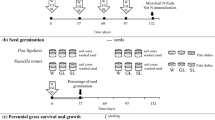Summary
Allelopathic effect ofEupatorium riparium Regel, a dominant ruderal weed at higher altitudes in Meghalaya state in north-eastern India, was studied on two common sympatric annual weeds,Galinsoga ciliata (Raf.) andG. parviflora Cav. and on soil microbes. Seed germination and radicle and plumule growth of both species ofGalinsoga were suppressed by the aqueous extract and leachate ofE. riparium. Although the leaf leachate, leaf and litter extracts and litter bed caused considerable reduction in leaf area and seed and dry matter production in both species ofGalinsoga, the effect was much more pronounced onG. parviflora. The inhibitory effect was directly correlated with the concentration of the extract and leachate. The soil microbial population and growth of theGalinsoga spp. declined considerably in the experimental pots where the soil had earlier received leachate of different plant parts ofE. riparium growing in it. The presence of the partly decomposed litter ofE. riparium in the pots reduced soil microbial population and growth of the two weeds much more strongly as compared to the litter in the advanced stages of decomposition. The study also revealed that the abundance and colony growth of the two test fungiviz. Trichoderma viride andAspergillus flavus were differentially affected by the allelopathy ofE. riparium; T. viride being favoured andA. flavus inhibited.
Similar content being viewed by others
References
Akhtar N, Naqui H H and Hussain F 1978 Biochemical inhibition (allelopathy) exhibited byCenchrus ciliaris Linn. andChrysopogan aucheri (Bioss) Staff. Pak. J. For. 28, 194–200.
del Moral R and Cates R R 1971 Allelopathic potential of dominant vegetation of Western Washington. Ecology 52, 1030–1037.
Dirvi G A and Hussain F 1979 Allelopathic effects ofDichanthium annulatum (Forssk) Staff. on some cultivated species. Pak. J. Sci. Ind. Res. 22, 194–199.
Friedman J, Orshan G and Ziger efir Y 1977 Suppression of annuals byArtemisia herbaalba in the Negev desert of Israel. J. Ecol. 65, 413–426.
Hull J C and Muller C H 1977 The potential for dominance byStipa pulchra in a California grassland Am. Midl. Nat. 97, 147–175.
Hussain F and Gadoon M A 1981 Allelopathic effects ofSorghum vulgare Pers. Oecologia 51, 284–288.
Kein R 1975 Quantitative effects of incorporating rice residue on populations of soil microflora. Mycologia 67, 283–287.
Lockerman R H and Putnam A R 1981 Mechanisms for differential interference among cucumber (Cucumis sativus L.) accessions. Bot. Gaz. 142, 427–430.
Lodhi M A K 1976 Role of allelopathy as expressed by dominating trees in a lowland forest in controlling the productivity and pattern of herbaceous growth. Am. J. Bot. 63, 1–8.
Lodhi M A K 1978 Comparative inhibition of nitrifiers and nitrification in a forest community as a result of allelopathic nature of various tree species. Am. J. Bot 65, 1135–1142.
Mishra R R and Sharma G D 1977 Ecology of soil fungi: Population variation in relation to varying cover vegetation and soil factors. Syd. Ann. Mycol. Ser. II, 30, 134–140.
Muller C H 1969 Allelopathy as a factor in ecological process. Vegetatio 18, 348–357.
Naqui H H and Muller C H 1975 Biochemical inhibition (Allelopathy) exhibited by Italian-Rye grass (Lolium multiflorum). Pak. J. Bot. 7, 139–147.
Neill R L and Rice E L 1971 Possible role ofAmbrosia psilostachya on patterning succession in old fields. Am. Midl. Nat. 86, 344–357.
Newman E I and Rovira A D 1975 Allelopathy among some British grassland species. J. Ecol. 63, 727–737.
Parker V T and Muller C H 1979 Allelopathic dominance by tree-associated herb in a California annual grassland. Oecologia 37, 315–320.
Putnam A R and Duke W B 1978 Allelopathy in agroecosystems. Ann. Rev. Phytopathol. 16, 431–451.
Rai J P N and Tripathi R S 1982 Allelopathy as a factor contributing to dominance ofEupatorium riparium Regel. Indian. J. Ecol. 9, 14–20.
Rice E L 1974Allelopathy, Academic Press Inc., New York.
Rice E L 1977 Some roles of allelopathic compounds in plant communities. Biochem. Syst. Ecol. 5, 201–206.
Rice E L 1979 Allelopathy—an update. Bot. Rev. 45, 15–109.
Rovira A D 1969 Plant root exudate. Bot. Rev. 35, 35–39.
Schlatterer E F and Tisdale E W 1969 Effects of litter ofArtermisia, Chrysothamnus andTortula on germination and growth of three perennial, grasses. Ecology 50, 869–873.
Stowe, L G 1979 Allelopathy and its influence on the distribution of plants in an Illinois old field. J. Ecol. 67, 1065–1085.
Tripathi R S, Singh R S and Rai J P N 1981 Allelopathic potential ofEupatorium adenophorum—a dominant ruderal weed of Meghalaya. Proc. Indian natn. Sci. Acad. B 47, 458–465.
Usami Y 1976 Ecological studies on weeds in mulberry fields. 2, Auto-ecology ofGalinsoga parviflora Cav. Weed Res. Japan 21, 76–80.
Walkley A and Black I A 1934 An examination of the Degtjareff method for determining soil organic matter and proposed modification of the chromic acid titration method. Soil. Sci. 37, 29–38.
Whittaker R H 1970 Communities and Ecosystems. Macmillan, New York.
Whittaker R H 1971 The Chemistry of communitiesIn Biochemical Interactions Among Plants, Nat. Acad. Sci. Washington.
Whittaker R H and Feeny P P 1971 Allelochemics: Chemical interactions between species. Science 171, 757–770.
Author information
Authors and Affiliations
Rights and permissions
About this article
Cite this article
Rai, J.P.N., Tripathi, R.S. Allelopathic effects ofEupatorium riparium on population regulation of two species ofGalinsoga and soil microbes. Plant Soil 80, 105–117 (1984). https://doi.org/10.1007/BF02232944
Received:
Revised:
Issue Date:
DOI: https://doi.org/10.1007/BF02232944




